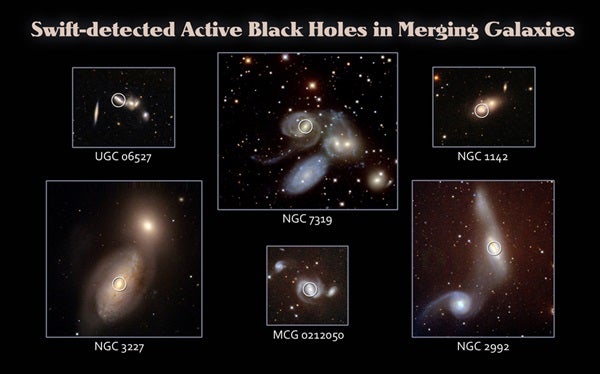Data from an ongoing survey by NASA’s Swift satellite has helped astronomers solve a decades-long mystery about why a small percentage of black holes emit vast amounts of energy.
Only about 1 percent of supermassive black holes exhibit this behavior. The new findings confirm that black holes “light up” when galaxies collide, and the data may offer insight into the future behavior of the black hole in our own Milky Way Galaxy.
The intense emission from galaxy centers, or nuclei, arises near a supermassive black hole containing between a million and a billion times the Sun’s mass. Giving off as much as 10 billion times the Sun’s energy, some of these active galactic nuclei (AGN) are the most luminous objects in the universe. They include quasars and blazars.
“Theorists have shown that the violence in galaxy mergers can feed a galaxy’s central black hole,” said Michael Koss, the study’s lead author from the University of Maryland in College Park. “The study elegantly explains how the black holes switched on.”
Until Swift’s hard X-ray survey, astronomers never could be sure they had counted the majority of the AGN. Thick clouds of dust and gas surround the black hole in an active galaxy, which can block ultraviolet, optical, and low-energy, or soft X-ray, light. Infrared radiation from warm dust near the black hole can pass through the material, but it can be confused with emissions from the galaxy’s star-forming regions. Hard X-rays can help scientists directly detect the energetic black hole. Since 2004, the Burst Alert Telescope (BAT) aboard Swift has been mapping the sky using hard X-rays.
“Building up its exposure year after year, the Swift BAT Hard X-ray Survey is the largest, most sensitive, and complete census of the sky at these energies,” said Neil Gehrels, Swift’s principal investigator at NASA’s Goddard Space Flight Center in Greenbelt, Maryland.
The survey, which is sensitive to AGN as far as 650 million
light-years away, uncovered dozens of previously unrecognized systems.
“The Swift BAT survey is giving us a very different picture of AGN,” Koss said. The team finds that about a quarter of the BAT galaxies are in mergers or close pairs. “Perhaps 60 percent of these galaxies will completely merge in the next billion years. We think we have the smoking gun for merger-triggered AGN that theorists have predicted.”










